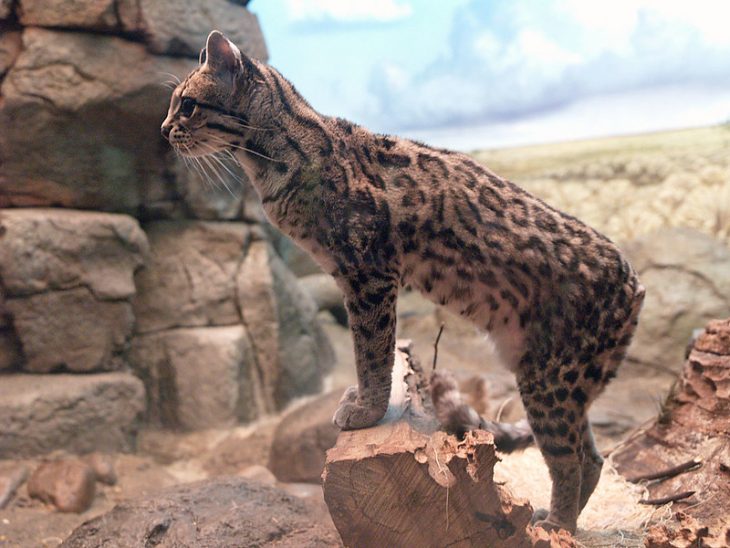
The Margay (Leopardus wiedii) is a small wild cat that inhabits the dense forests of Central and South America. Known for its stunning appearance and elusive behavior, the Margay has captivated the interest of wildlife enthusiasts and researchers alike. In this article, we will dive into the captivating world of the Margay and discover fascinating facts about this enigmatic feline.
Distinct Coat
Margays have a beautiful coat pattern consisting of a background color that ranges from tawny to grayish-brown, adorned with dark spots and rosettes. This pattern serves as camouflage, allowing them to blend seamlessly into their forest habitat.
Long, Graceful Tail
One of the Margay’s most remarkable features is its long, bushy tail. The tail, which can be as long as its body, aids in balance and provides stability while climbing trees.
Large Eyes
The Margay has proportionally large eyes compared to its body size. Its eyes are adapted for excellent night vision, allowing it to navigate its arboreal habitat during the darker hours.
Flexible Ankles
Margays have specialized ankle joints that provide them with exceptional climbing abilities. These flexible ankles allow them to rotate their hind legs up to 180 degrees, making it easier to climb down trees headfirst.
Elusive and Solitary Lifestyle
Margays are solitary animals, usually avoiding contact with others of their kind except during the mating season. Their elusive nature and exceptional camouflage make Margays difficult to spot in the wild, contributing to their reputation as one of the most enigmatic and mysterious cat species.

Climbing Agility
Margays possess strong forelimbs and flexible shoulders, enabling them to traverse tree branches with incredible agility and precision. They can move quickly and silently through the dense foliage, making them elusive and challenging to spot.
Tree Hunting
Margays are skilled hunters, often ambushing their prey from the treetops. They use their exceptional leaping ability to pounce on unsuspecting birds or small mammals passing below.
Tail as an Aid
The Margay’s long and prehensile tail acts as a counterbalance, providing stability and aiding in navigating narrow branches. This unique adaptation allows them to move with grace and precision in the tree canopy.
Predator Avoidance
Margays have adapted to a nocturnal lifestyle to reduce competition and avoid encounters with larger predators such as jaguars and ocelots that are more active during the day.
Prey Availability
Many of the Margay’s preferred prey, such as rodents, birds, and arboreal mammals, are more abundant and active during the night. By hunting under the cover of darkness, Margays increase their chances of a successful hunt.
Meow
Margays have a unique meow that sounds like a combination of a domestic cat’s meow and a high-pitched cry. They use this sound to communicate with their mothers during the early stages of life.
Growl and Hiss
When threatened or agitated, Margays emit deep growls and hisses as a warning signal. These sounds serve to deter potential threats and display their readiness to defend themselves.
Chattering
Margays are known for their chattering vocalization, which sounds like a rapid series of high-pitched chirps. They often make this sound when excited or during encounters with other Margays.
Nocturnal Habits
Margays are active during the night, making it difficult for researchers to monitor their behavior and study them in their natural habitat.
Crypsis and Camouflage
Margays have excellent camouflage, blending seamlessly into their forest environment. Their spotted coat pattern helps them stay hidden from potential predators and prey alike.
IUCN Red List
The Margay is currently listed as “Near Threatened” on the International Union for Conservation of Nature (IUCN) Red List of Threatened Species.
Protected by Legislation
The Margay is protected by law in many countries, making it illegal to hunt, capture, or trade them without proper permits.

Conservation Efforts
Various organizations and conservationists are actively working to protect the Margay’s habitat, raise awareness about its conservation needs, and combat illegal wildlife trade.
Low Population Density
Margays have relatively low population densities due to habitat loss and fragmentation. Their elusive nature makes it harder to estimate their population size accurately.
Conclusion
The Margay is a mysterious and captivating wild cat that thrives in the dense forests of Central and South America. Its exquisite appearance, arboreal adaptations, nocturnal behavior, vocal communication, and elusive nature make it a truly remarkable species. By delving into the world of the Margay, we gain a deeper appreciation for the wonders of the natural world and the diverse creatures that inhabit it.
Frequently Asked Questions (FAQs)
Where do Margays live?
Margays are native to the dense forests of Central and South America, including countries such as Mexico, Brazil, Peru, and Costa Rica.
What do Margays eat?
Margays are carnivores and primarily feed on small mammals, birds, reptiles, and amphibians. Their diet includes animals such as rodents, squirrels, birds, lizards, and frogs.
Are Margays endangered?
Margays are currently classified as “Near Threatened” by the International Union for Conservation of Nature (IUCN). Habitat loss, deforestation, and illegal hunting pose significant threats to their population.
Can Margays be kept as pets?
Margays are wild animals and should not be kept as pets. They require specific habitats, diets, and enrichment that cannot be adequately provided in a domestic setting.
How high can Margays jump?
Margays are excellent jumpers and can leap up to 12 feet vertically from a stationary position. Their strong hind legs and flexible bodies allow them to perform impressive leaps while hunting or moving through the treetops.
Was this page helpful?
Our commitment to delivering trustworthy and engaging content is at the heart of what we do. Each fact on our site is contributed by real users like you, bringing a wealth of diverse insights and information. To ensure the highest standards of accuracy and reliability, our dedicated editors meticulously review each submission. This process guarantees that the facts we share are not only fascinating but also credible. Trust in our commitment to quality and authenticity as you explore and learn with us.


